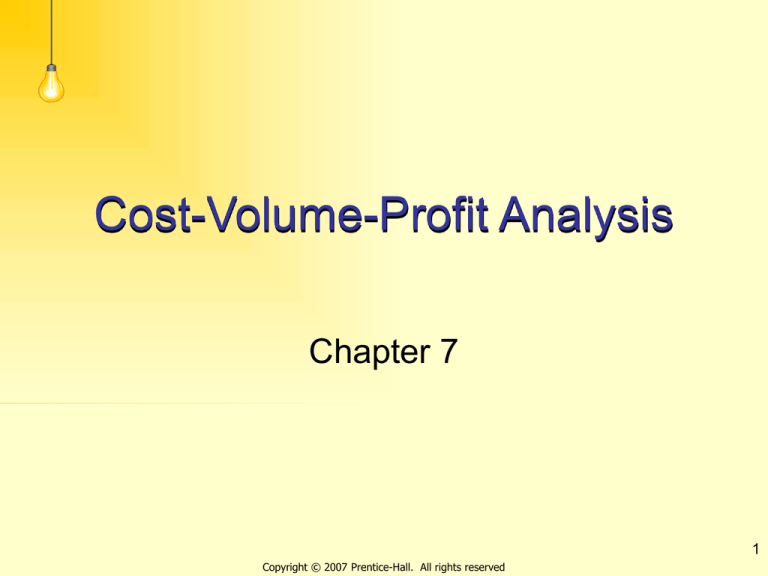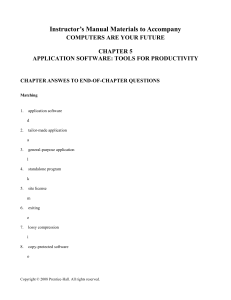
Cost-Volume-Profit Analysis
Chapter 7
1
Copyright © 2007 Prentice-Hall. All rights reserved
Objective 1
Calculate the unit contribution
margin and the contribution
margin ratio
2
Copyright © 2007 Prentice-Hall. All rights reserved
Components of CVP Analysis
•
•
•
•
•
Sales price per unit
Volume sold
Variable costs per unit
Fixed costs
Operating income
3
Copyright © 2007 Prentice-Hall. All rights reserved
CVP Assumptions
1. Change in volume is only factor that
affects costs
2. Can classify each cost as either variable
or fixed. (These costs are linear
throughout relevant range)
3. Revenues are linear throughout relevant
range
4. Inventory levels will not change
5. The sales mix of products will not change
4
Copyright © 2007 Prentice-Hall. All rights reserved
Unit Contribution Margin
Sales price per unit
- Variable costs per unit
Contribution margin per unit
5
Copyright © 2007 Prentice-Hall. All rights reserved
Contribution Margin Ratio
Unit contribution margin
Sales price per unit
6
Copyright © 2007 Prentice-Hall. All rights reserved
Objective 2
Use CVP analysis to find
breakeven points and target profit
volumes
7
Copyright © 2007 Prentice-Hall. All rights reserved
Breakeven Point
• Sales level at which operating income is
zero
• Sales above breakeven result in a profit
• Sales below breakeven result in a loss
8
Copyright © 2007 Prentice-Hall. All rights reserved
Income Statement Approach
Contribution Margin Income Statement
Sales
- Variable Costs
Contribution Margin
- Fixed Costs
Operating Income
9
Copyright © 2007 Prentice-Hall. All rights reserved
Short-Cut Approach Using the Unit
Contribution Margin
Units sold =
Fixed expenses + Operating income
Contribution margin per unit
10
Copyright © 2007 Prentice-Hall. All rights reserved
Short-Cut Approach Using the Unit
Contribution Margin Ratio
Sales in $ =
Fixed expenses + Operating income
Contribution margin ratio
11
Copyright © 2007 Prentice-Hall. All rights reserved
E7-15 1.
Contribution margin ratio =
Contribution margin ÷ Sales =
$187,500 ÷ $312,500 = 60%
12
Copyright © 2007 Prentice-Hall. All rights reserved
E7-15 1.
Aussie Travel
Contribution Margin Income Statements
Sales revenue
$250,000 $360,000
Variable expenses (40%)
100,000
144,000
Contribution margin
$150,000 $216,000
Fixed expenses
170,00
170,000
Operating income (loss)
$ (20,000)
$46,000
13
Copyright © 2007 Prentice-Hall. All rights reserved
E7-15 2.
Sales in $ =
Fixed expenses + Operating income
Contribution margin ratio
Sales in $ = $170,000 + $0 = $283,333
60%
14
Copyright © 2007 Prentice-Hall. All rights reserved
E7-16 1
Contribution margin = Sales–Variable costs
= $1.70 - $0.85
= $0.85
Contribution margin ratio:
Contribution margin per unit = $0.85 = 50%
Sales price per unit
$1.70
15
Copyright © 2007 Prentice-Hall. All rights reserved
E7-16 2
Breakeven sales in units:
Fixed costs + Operating income
Contribution margin per unit
($85,000 + $0) / $0.85 = 100,000 units
16
Copyright © 2007 Prentice-Hall. All rights reserved
E7-16 2
Breakeven sales in dollars:
Fixed costs + Operating income
Contribution margin ratio
($85,000 + $0) / 50% = $170,000
17
Copyright © 2007 Prentice-Hall. All rights reserved
E7-16 3
Sales in units:
Fixed costs + Operating income
Contribution margin per unit
($85,000 + $25,000) / $0.85 = 129,412 units
18
Copyright © 2007 Prentice-Hall. All rights reserved
Preparing a CVP Chart
Step 1:
– Choose a sales volume.
– Plot point for total sales revenue.
– Draw sales revenue line from origin.
19
Copyright © 2007 Prentice-Hall. All rights reserved
Preparing a CVP Chart
$20,000
Dollars
$15,000
•
$10,000
Revenues
$5,000
$0
0
500
1,000
1,500
Volume of Units
20
Copyright © 2007 Prentice-Hall. All rights reserved
Preparing a CVP Chart
Step 2:
– Draw the fixed cost line
21
Copyright © 2007 Prentice-Hall. All rights reserved
Preparing a CVP Chart
$20,000
Dollars
$15,000
Revenues
Fixed costs
$10,000
$5,000
$0
0
500
1,000 1,500
Volume of Units
22
Copyright © 2007 Prentice-Hall. All rights reserved
Preparing a CVP Chart
Step 3:
– Draw the total cost line ( fixed plus variable)
23
Copyright © 2007 Prentice-Hall. All rights reserved
Preparing a CVP Chart
$20,000
Dollars
$15,000
Revenues
Fixed costs
Total cost
$10,000
$5,000
$0
0
500
1,000 1,500
Volume of Units
24
Copyright © 2007 Prentice-Hall. All rights reserved
Preparing a CVP Chart
Step 4:
– Identify the breakeven point and the areas of
operating income and loss
25
Copyright © 2007 Prentice-Hall. All rights reserved
Preparing a CVP Chart
$20,000
Breakeven point
Dollars
$15,000
$10,000
$5,000
$0
0
500
1,000
1,500
Volume of Units
26
Copyright © 2007 Prentice-Hall. All rights reserved
Preparing a CVP Chart
Step 5:
– Mark operating income and operating loss
areas on graph
27
Copyright © 2007 Prentice-Hall. All rights reserved
Preparing a CVP Chart
$20,000
Breakeven point
Dollars
$15,000
$10,000
$5,000
$0
0
500
1,000
1,500
Volume of Units
28
Copyright © 2007 Prentice-Hall. All rights reserved
E7-20
Dollars (in thousands)
$70,000
$60,000
$50,000
$40,000
$30,000
$20,000
$10,000
$0
600
1,200
1,800
2,400
Tickets (in thousands)
29
Copyright © 2007 Prentice-Hall. All rights reserved
E7-20
Dollars (in thousands)
$70,000
$60,000
$50,000
$40,000
$30,000
Fixed Costs
$20,000
$10,000
$0
600
1,200
1,800
2,400
Tickets (in thousands)
30
Copyright © 2007 Prentice-Hall. All rights reserved
E7-20
Dollars (in thousands)
$70,000
$60,000
Breakeven point
$50,000
$40,000
$30,000
Fixed Costs
$20,000
$10,000
$0
600
1,200
1,800
2,400
Tickets (in thousands)
31
Copyright © 2007 Prentice-Hall. All rights reserved
E7-20
Dollars (in thousands)
$70,000
$60,000
$50,000
$40,000
$30,000
$20,000
$10,000
$0
600
1,200
1,800
2,400
Tickets (in thousands)
32
Copyright © 2007 Prentice-Hall. All rights reserved
E7-20
($24 x units sold)-($4 x units sold)-$24,000,000 = $0
($20 x units sold) = $0 + $24,000,000
Units sold = $24,000,000 ÷ $20 = 1,200,000 tickets
1,200,000 x $24 per ticket = $28,800,000
33
Copyright © 2007 Prentice-Hall. All rights reserved
Objective 3
Perform sensitivity analysis in
response to changing business
conditions
34
Copyright © 2007 Prentice-Hall. All rights reserved
Sensitivity Analysis
• “What if” analysis
• What if the sales price changes?
• What if costs change?
35
Copyright © 2007 Prentice-Hall. All rights reserved
E7-22
Sales needed to Breakeven =
Fixed Costs ÷ Contribution Margin Ratio
$500,000 = Fixed Costs ÷ .40
$500,000 × .40= Fixed Costs
$200,000 = Fixed Costs
New fixed costs = $240,000
36
Copyright © 2007 Prentice-Hall. All rights reserved
E7-22
Sales needed to Breakeven =
Fixed Costs ÷ Contribution Margin Ratio
$240,000 ÷ .40 = $600,000
37
Copyright © 2007 Prentice-Hall. All rights reserved
E7-23
Sale price per scarf
Contribution margin ratio
Contribution margin per unit
$16
x.625
$10
Scarves needed to pay for extra entrance
fee cost of $150 ($1,000 x 15%):
$150 ÷ $10 = 15 scarves
38
Copyright © 2007 Prentice-Hall. All rights reserved
Objective 4
Find breakeven and target profit
volumes for multiproduct
companies
39
Copyright © 2007 Prentice-Hall. All rights reserved
Multiple Product Break-Even
Point – E7-27
Step 1: Calculate weighted-average contribution
margin
Standard
Sale price per unit
$54
Variable costs per unit
36
Contribution margin per unit
$18
Sales mix in units
x3
Contribution margin
$54
Weighted average contribution
Margin per unit ($110 / 5)
Chrome
$78
50
$28
x2
$56
Total
$110
$22
40
Copyright © 2007 Prentice-Hall. All rights reserved
Multiple Product Break-Even
Point – E7-27
Step 2: Calculate the breakeven point in units
Fixed costs + Operating income
Weighted average contribution margin per unit
($9,680 + $0) ÷ $22 = 440 composite units
41
Copyright © 2007 Prentice-Hall. All rights reserved
Multiple Product Break-Even
Point – E7-27
Step 3: Calculate the breakeven point in
units for each product line
Standard: 440 units x 3/5 = 264 units
Chrome: 440 units x 2/5 = 176 units
42
Copyright © 2007 Prentice-Hall. All rights reserved
E7-27
To earn $6,600
Fixed costs + Operating income
Weighted average contribution margin per unit
($9,680 + $6,600) ÷ $22 = 740 composite units
Standard: 740 x 3/5 = 444
Chrome: 740 x 2/5 = 296
43
Copyright © 2007 Prentice-Hall. All rights reserved
Objective 5
Determine a firm’s margin of
safety and operating leverage
44
Copyright © 2007 Prentice-Hall. All rights reserved
Margin of Safety
• Excess of expected sales over breakeven
sales
• Drop in sales that the company can
absorb before incurring a loss
• Used to evaluate the risk of current
operations
45
Copyright © 2007 Prentice-Hall. All rights reserved
Margin of Safety
In units:
Expected sales in units – Breakeven sales in units
In dollars:
Margin of safety in units x Sale price per unit
46
Copyright © 2007 Prentice-Hall. All rights reserved
Margin of Safety As a Percentage
Margin of safety in units ÷ Expected sales in units
In dollars:
Margin of safety in $ ÷ Expected sales in $
47
Copyright © 2007 Prentice-Hall. All rights reserved
E7-32 1.
Margin of safety = Expected sales – breakeven sales
Expected sales:
Sales – variable costs – fixed costs = operating income
Sales – 70% Sales - $9,000 = $12,000
30% Sales = $9,000 + $12,000
Sales = $70,000
48
Copyright © 2007 Prentice-Hall. All rights reserved
E7-32 1.
Margin of safety = Expected sales – breakeven sales
Breakeven sales:
Sales – variable costs – fixed costs = operating income
Sales - 70% x Sales - $9,000 = $0
30% Sales = $9,000
Sales = $30,000
49
Copyright © 2007 Prentice-Hall. All rights reserved
E7-32 1.
Margin of safety = Expected sales – breakeven sales
= $70,000 - $30,000
= $40,000
50
Copyright © 2007 Prentice-Hall. All rights reserved
E7-32 2.
Margin of safety as a % of target sales =
$40,000 ÷ $70,000 = 57%
51
Copyright © 2007 Prentice-Hall. All rights reserved
Operating Leverage
• Relative amount of fixed and variable
costs that make up total costs
• Operating leverage factor:
Contribution margin
Operating income
Indicates percentage change in operating
income that will occur from a 1% change
in volume
52
Copyright © 2007 Prentice-Hall. All rights reserved
Operating Leverage
• High operating leverage
– relatively more fixed costs
– relatively high contribution margin ratio
• Higher risk if volume decreases
• Higher potential for reward if volume
increases
53
Copyright © 2007 Prentice-Hall. All rights reserved
Operating Leverage
• Low operating leverage
– relatively more variable costs
– relatively small contribution margin ratio
• Lower risk if volume decreases
• Lower potential for reward if volume
increases
54
Copyright © 2007 Prentice-Hall. All rights reserved
Operating Leverage Factor
Contribution margin
Operating income
55
Copyright © 2007 Prentice-Hall. All rights reserved
E7-32 3.
Sales
Variable costs (70%)
Contribution margin
$70,000
49,000
$21,000
Operating leverage:
Contribution margin ÷ Operating income
$21,000 ÷ $12,000 = 1.75
56
Copyright © 2007 Prentice-Hall. All rights reserved
E7-32 4.
If volume decreases 10%, income will
decrease: 10% x 1.75 = 17.5%
57
Copyright © 2007 Prentice-Hall. All rights reserved
End of Chapter 7
58
Copyright © 2007 Prentice-Hall. All rights reserved









